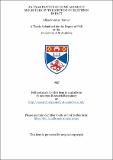Files in this item
An examination of some aromatic molecules by the method of electron impact
Item metadata
| dc.contributor.advisor | Horrex, Charles | |
| dc.contributor.author | Hamer, Allan Norman | |
| dc.coverage.spatial | 123 p. | en_US |
| dc.date.accessioned | 2018-07-18T11:00:41Z | |
| dc.date.available | 2018-07-18T11:00:41Z | |
| dc.date.issued | 1957 | |
| dc.identifier.uri | https://hdl.handle.net/10023/15529 | |
| dc.description.abstract | The thesis begins with an account of the behaviour of molecules on electron impact and explains how bond dissociation energies may be deduced from a study of ionization processes. The experimental work was carried out with a mass spectrometer designed and built for the purpose, and a full description of this instrument is provided, together with an account of the problems which arose during its construction and development, and the performance of which it was ultimately capable. After the reliability of the instrument had been tested by investigating some simple ionization processes, it was used to study the formation of benzyl ions from a number of related aromatic compounds. When the appearance potentials obtained in this way are combined with the ionization potential of the benzyl radical (which is the subject of a separate and direct determination) it is possible to make provisional estimates of the benzyl-x bond energy in dibenzyl, benzyl chloride, and benzyl iodide. The derived value of D (PhCH₂ -CH₂Ph) is used to verify Swarc's value of 77.5 kcal for D (PhCH₂ -H). From this quantity, the following bond energies may be deduced thermochemically: D (PhCH₂ -CH₂Ph) - 45±3 kcal;/ D (PhCH₂ -CH₃) - 63±3 kcal; D(PhCH₂-Ph) - 74.4±3 kcal, D (PhCH₂ -I) - 36.6±4 kcal; D (PhCH₂ -C1) - 62±4 kcal. The last two values are confirmed by the direct electron impact data. Lastly, an indirect estimate of I(Ph) - 9.7 eV is based on a measurement of the appearance potential of this radical from benzene, and a thermochemical value for D (Ph-H). The thesis ends with a description of how the instrument was modified by the inclusion of a reactor furnace in order to study the mechanisms of thermal decomposition reactions. Results are included of a brief experiment involving the pyrolysis of benzyl iodide out by this means. | en_US |
| dc.language.iso | en | en_US |
| dc.publisher | University of St Andrews | |
| dc.subject.lcc | QD651.H2 | |
| dc.title | An examination of some aromatic molecules by the method of electron impact | en_US |
| dc.type | Thesis | en_US |
| dc.type.qualificationlevel | Doctoral | en_US |
| dc.type.qualificationname | PhD Doctor of Philosophy | en_US |
| dc.publisher.institution | The University of St Andrews | en_US |
This item appears in the following Collection(s)
Items in the St Andrews Research Repository are protected by copyright, with all rights reserved, unless otherwise indicated.

